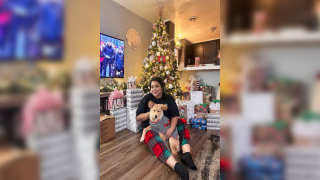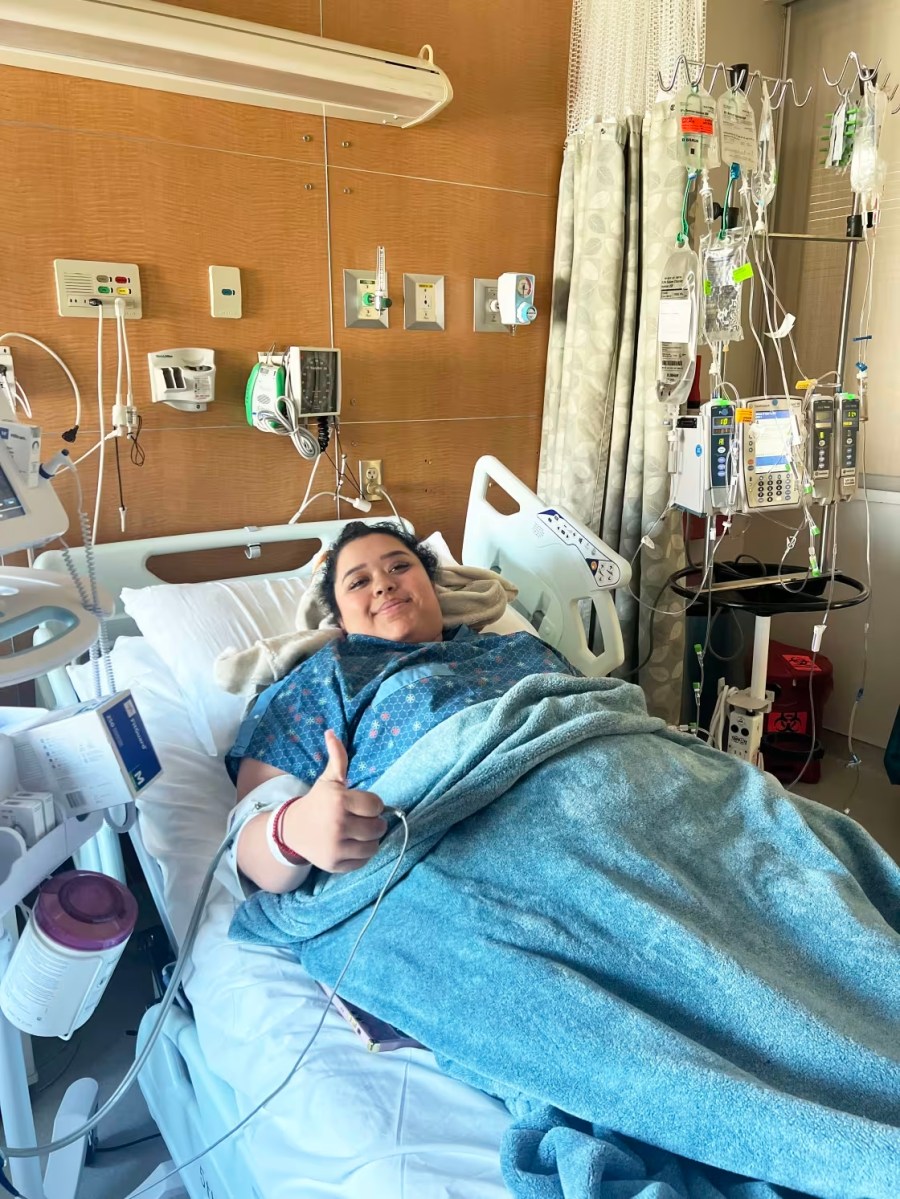
At the end of 2021, Johanna Mendoza, then 22, was in Mexico on vacation when she developed little red dots on her wrist.
“I thought maybe I just ate something that was no good for my body,” the 25-year-old from Inglewood, California, tells TODAY.com.
Then the splotches began appearing other places on her body. When she returned home, she visited the emergency room and was diagnosed with acute lymphocytic leukemia (ALL). She was told she needed a blood stem cell transplant to treat it.

“I was definitely surprised,” she says. “(It) was definitely scary.” Red blotches on skin reveal cancer
Even though Mendoza never experienced any serious allergies, when the red splotches first appeared on her wrist, she wondered if that was the cause.
“I thought maybe I was having some type of reaction to something that I ate,” she explains. “It was a weird thing.”
Then the red dots appeared all over her body. “That made me worry,” Mendoza says.
A day or so later, she went to the doctor in Mexico, and after some bloodwork, she was told she had low platelets, cells in the blood that help with clotting and in low amounts can indicate a medical problem.
At the end of her vacation, Mendoza return to California and visited the emergency room in early 2022. Doctors there also ran tests and became troubled by what they found.
“They actually told me that I was not going to be able to go home. They wanted me to stay overnight for more bloodwork," she recalls. After more tests, Mendoza remembers the doctor telling her, "I see something concerning, but I don’t want to tell you yet until I get a positive result.”
Soon Mendoza learned she had ALL, a quick-progressing cancer of the blood and bone marrow. At first, she needed to receive numerous blood transfusions to bolster her blood platelet count, and she stayed in the hospital for more than two months.
“My platelets were very low,” she says. “I was stuck in the room.”
Being isolated in the hospital also protected her because her immune system was compromised. Doctors worried that if she developed an infection, she would become sicker.
While she knew why it was important to stay in the hospital, she struggled at times. “It was definitely very hard on me,” Mendoza says.
Once her platelet count was high enough, she went home. But she still needed to undergo chemotherapy and a bone marrow transplant. Initially, she thought her twin sister could be her donor, but they learned that they were not actually a good match.

They also considered her half brother as a possible donor, but he wasn’t a match either. Doctors enrolled her a clinical trial looking at partial matches for people needing bone marrow transplants.
“We actually found one really quickly, which was shocking,” Mendoza says. “I thought it was going to be a longer process.”
Partial bone marrow matches
When it comes to bone marrow transplants, also called stem cell transplants, finding a match can be difficult. Stem cells mostly live in bone marrow, the center of the bones.
Traditionally, these transplants require the donor and the recipient to share an HLA type, according to NMDP, formerly known as the National Marrow Donor Program and Be The Match. HLAs are a type of protein found on most cells throughout the body. A perfect match, which has long been the standard, means eight out of eight HLA markers match, Dr. Steven Devine says. But finding perfect matches can be challenging.
“Not everyone can find even a match,” the chief medical officer of NMDP Biotherapies, which participated in the clinical trial Mendoza was in, tells TODAY.com. “Outcomes are better … if you get transplanted using either a matched sibling ... or a match volunteer unrelated donor.”
Devine says only 30% of patients, though, have a family match. Finding a random match can take time and be difficult depending on a person's race. White people, for example, have an 80% chance of finding a match on a donor registry, whereas Black people have only a 29% chance and for Asian or Hispanic people, like Mendoza, it's slightly less than 50%.
“There’s a big gap in the likelihood of finding what we would have historically considered to be a perfectly matched donor," Devine says.
To address the gap in access, NMDP spearheaded the trial to see if people could receive a partial match and still have a successful outcome.
“We said, ‘Well, we have to find ways to improve outcomes with using donors who are less than perfectly matched,’” Devine recalls.
When the donor is not a perfect match, the patient can experience what’s called graft-versus-host disease (GVHD), he says. This occurs when the immune system attacks the donated stem cells, according to the National Institute of Health. It affects multiple systems in the body and ranges in severity from mild to life-threatening, the Leukemia and Lymphoma Society says.
“Traditionally, the rates of GVHD have been much much higher if the donor ... isn’t matched fully,” Devine says.
The clinical trial that Mendoza was in looked at whether giving the chemotherapy drug cyclophosphamide on the third and fourth days following a stem cell transplant can prevent GVHD. Giving the medication post-transplant makes the body more hospitable and prevents a reaction from the donor’s T cells, part of the immune system, which contributes to graft-versus-host disease, Devine says.
“Doing that actually substantially lowers the risk of graft-versus-host disease, even using a donor who less than perfectly matches,” Devine says. “It’s been a game changer.”
It could also have applications outside cancer, such as anemia or sickle cell disease.
While the trial investigating post-transplant cyclophosphamide in adults has been completed, the researchers are still looking at this in pediatric populations. Now, adult patients who were not involved in the research can receive this protocol if they can’t find a perfect match. Devine says they’ve done transplants in people with seven out of eight HLA marker matches and as low as five.
“It’s already being done now in our field as a standard of care,” Devine says. “It means that more people have the potential to have access to a life-saving blood or bone marrow transplant.”
Being part of an imperfect match
When Catherine Vega was a freshman in college, she submitted a saliva sample with Be The Match. Then she forgot about it. Five years later, she received a call that she was a match to a stranger.
“There were no second thoughts,” Vega, 24, of San Antonio, Texas, tells TODAY.com. “It’s what I had to do. If I can help somebody, I will.”

For some stem cell transplants, the donor is put to sleep with general anesthesia, and a large needle is inserted into the hip to pull out the bone marrow, according to the American Cancer Society. In other cases, the donor takes medication to help the stem cells move from the marrow to the blood faster so the stem cells can be extracted directly from the blood.
After undergoing blood tests to make sure she could donate, she received the injections for a few days to boost blood cell and stem cell production in the body. On her donation day, she went to a hospital, where she sat for eight hours.
“You have needles in your arms obviously taking blood out (to remove the stem cells) and putting blood in,” she says. “I slept most of it. It was pretty chill.”
The next day, she returned for four hours and was done.
“They take the bags of your stem cells and then they transfer it and off it goes,” she says. “And that’s that.”
Prior to receiving the bone marrow transplant on Dec. 9, 2022, Mendoza underwent two months of 24/7 chemotherapy. When she went for the transplant, she felt surprised that she just needed to receive six bags of fluid and it wasn’t a more of a surgical procedure.
“It was smooth during that whole process,” she says. “It was like an hour.”
After undergoing the transplant and receiving the post-transplant cyclophosphamide, Mendoza needed to stay isolated in the hospital to avoid infection until the donated stem cells took over. That meant a lot of blood tests and waiting.
“It takes about two to three weeks … and you have to be patient,” she says. “I was definitely not patient."
Luckily, she experienced a “Christmas miracle” and was able to go home on Christmas Eve.
“The transplant is the finish line,” she says. “Once I got my transplant I was like, ‘OK, so we should be good.’”
Mendoza had a bone marrow biopsy 100 days after her transplant and is now cancer free. She’s sharing her story to encourage others facing challenges.
“Life throws you a curveball, but just because it throws it at you doesn’t mean you have to give up,” she says. "Keep going and keep crushing it."
This story first appeared on TODAY.com. More from TODAY:



